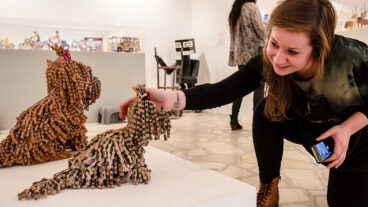I had never before seen black Africans so joyfully embraced by non-Africans.
I recently went searching for my grandmother’s long-forgotten gravesite. I left my home in Los Angeles for the heartland of Ohio, where I had grown up and where she was buried.
After bureaucratic runarounds, I was finally directed to an overgrown cemetery. I found my grandmother’s gravesite but, like all the surrounding sites, it had been desecrated with swastikas and antisemitic slurs. The caretaker told me the cemetery was largely Jewish, as though this fact explained or even justified the desecration. But neither my grandmother nor I am Jewish. We are African-American. This ethnic distinction, though, didn’t spare my grandmother’s gravesite. One look at her grave and I knew, without a shadow of a doubt, that those who hate Jews hated her, too
This forgotten cemetery exposed one of America’s worst-kept secrets: There are two Americas, one privileged and one still suffering from prejudice. We like to think the United States is a great melting pot, but it is not always so. Americans of different nationalities, religions and colors are bitterly divided.
In our cities, ethnic enclaves are sealed off from one another. A Latino teenager might never meet a Korean or African-American teen, even though their neighborhoods are within a few miles of each other. A privileged suburbanite knows little about an inner-city kid because their paths rarely cross.
This is even truer for the heartland of America, where minorities often remain marginalized. Our failure at true integration allows stereotypes to flourish, so when some minorities venture out of their neighborhoods, they are viewed with suspicion or even hatred. Prejudice bubbles beneath the surface, erupting occasionally, as it did in my grandmother’s cemetery.
One reason we have failed to eradicate prejudice is that the human rights community, which should be leading the fight for social justice in America, is instead focused almost exclusively on abuses committed everywhere in the world but here. That is not to say that human rights causes outside of our borders are not worthy of our attention. But as just as those causes are, they should not be the broom that sweeps America’s problems under the rug.
The human rights community is also at fault for disproportionately vilifying the one country that could teach America how to bridge its ethnic divide: Israel.
The Jewish state is a model of successful multiculturalism, yet in the international arena it is increasingly condemned as a pariah. To be sure, Israel – like any other country – has its own share of problems. Yet it is hard to fight the feeling that Israelis are being blamed for their problems, much like the five unfortunate rape survivors in Somalia who were stoned to death by Islamic fundamentalists for “adultery.” This vilification is to our detriment here in America, as we could learn a great deal about tolerance if we weren’t so concentrated on criticism.
I first became aware of Israel’s potential as a model for multicultural understanding when I caught a televised special on Israel’s rescue of Ethiopian Jews in 1991. I had never before seen black Africans so joyfully embraced by non Africans, so welcomed into a non-African country. I saw a white Israeli doctor weep with joy when he successfully delivered a black baby on the rescue plane, and I saw him hold that baby as though it were the most precious object in the world.
Soon after seeing those images, I flew to Israel to see the melting pot for myself. I found a pluralistic, modern democracy dedicated to the ingathering of exiles from around the world. I found immigrants from more than 100 countries across the globe. In this decade alone, Israel absorbed 1 million immigrants from the former Soviet Union, a staggering number considering
that Israel is hardly bigger than the state of Delaware.
Despite some initial and understandable adjustment difficulties, these immigrants have become integral parts of the country. Israel has managed to turn its mosaic of different colors, nationalities and religions into a relatively harmonious, political, cultural, social and economic whole.
My visit was an eye-opener, and I’ve since returned again and again. I started a program, Operation Unity, that utilizes kibbutz ideology to teach multicultural understanding to America’s inner-city youth. I bring African-American and Latino to Israel, where many find out for the first time that people of different backgrounds can indeed just get along.
Israel has succeeded at becoming a melting pot because it puts community ideals and cohesion above individual self-interest, above the superficial barriers of color, religion and ethnicity. It genuinely embraces its newcomers and sets their integration and sense of belonging as one of its highest priorities. Israel’s programs for immigrants, its schools, its social programs, its respect for differences and its remarkable freedoms have turned the country into one of the most open and culturally vital societies in the world.
Rather than looking to Israel as the root of discord and evil, the defenders of social justice should celebrate Israel’s steady flame of community, its warm acceptance of multiculturalism and its genuine effort to make all its citizens feel they belong to one big extended family. Turning a more appreciative eye toward Israel might even help us here in America to face the prejudice in our midst.
(Reprinted with permission from The Forward)












